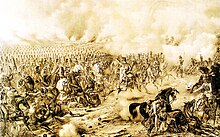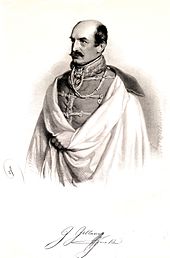Battle of Schwechat
Pákozd - Schwechat - Košice - Mór - Piski - Mediasch - Kápolna - Hatvan - Tápió Bicske - Isaszeg - Waitzen I - Nagy-Salló - Komorn I - Mocsa - Kács - Pered - Raab - Ács (Komorn II) - Komorn III - Hegyes - Waitzen II - Tura - Sighișoara - Debreczin - Szöreg - Temesvár
Arad - Deva - Esseg - Karlsburg - Komorn - Leopoldov - Oven - Peterwardein - Temesvár
The Battle of Schwechat was part of the beginning of the Hungarian War of Independence . There was an unequal battle here on October 30, 1848, in which about 40,000 Austrians and Croats with 140 guns faced about 23,500 Hungarians with 71 guns. Half of the Hungarians were inexperienced Landsturm who could not withstand the regular troops of the imperial superiority. Almost simultaneously with the defeat of the Hungarians, the end of the Vienna October Revolution was sealed.
prehistory
From the middle of March 1848 Hungary had been in a revolt against the sovereignty of imperial Austria . After the murder of Count Lamberg , Emperor Ferdinand refused to recognize the Batthyány government and ordered the dissolution of the Hungarian parliament, at the same time he appointed the Ban of Croatia , General Jelačić, as the new imperial administrator . Croatian contingents under the Banus Jelačić, defending themselves against the nationalist policy, were approaching Pesth via Stuhlweissenburg at the end of September . At the end of September, Lieutenant Field Marshal János Móga (1784–1861) was appointed Commander in Chief of the Hungarian Danube Army, which crossed the border on October 10th. A written request from the Banu to FML Móga to break away from the rebellion was unsuccessful. The banus continued to advance until he encountered the insurgents southwest of Ofen . In the battle of Pákozd on September 29th, the Hungarian insurgents fought southwest of Ofen, which ended in an armistice. The Croatians followed the emperor's call for help and marched on to Vienna to connect with the imperial troops outside the city. On October 6, a rebellion began in Vienna in favor of the Hungarians. The imperial war minister Theodor Baillet von Latour was lynched by the insurgent mob, the emperor and his court fled to Olomouc . On October 10th the Croatian outposts were on the Laaer Berge near Vienna, on the 12th they were united with the troops of Field Marshal Lieutenant Maximilian von Auersperg , and the Karger Brigade from Pressburg , the Count Wallmoden cuirassier regiment and Archduke also joined forces Franz Joseph-Dragoons to the troops of the Banus. In support of the uprising in Vienna, the Hungarian army, mostly Landsturm troops, moved across the border and reached the Leitha on the 28th , the Fischa on the 29th and advanced on the 30th against the position of the Banus near Schwechat .
Location on October 30th in Vienna
While Prince Windischgrätz was discussing the details of submission with the Viennese envoys, the Hungarians were advancing on the line between Mannswörth and Schwechat and Neu-Kettenhof. At around 2 o'clock in the afternoon the revolting Viennese were signaled from St. Stephen's Cathedral that the Hungarians were arriving; new courage filled the resistance that had already been given up. The commander of the rebels, Wenzel Messenhauser , immediately ordered a new sortie at the Red Tower Gate, which was supported by the batteries on the bastion. The white flags of the truce that had been put up in the morning were taken down and the battle flared up again. The Viennese pushed forward quickly, but were then thrown back in the Jägerzeile by the imperial soldiers under FML Hartlieb and Baron Csorich , where a new barricade was quickly erected. In Inzersdorf the command of the imperial II. Corps under Count Auersperg and in Breitensee the III. Corps stationed under Count Serbelloni . General Bem, at the head of 2000 men of the rebellious Viennese National Guard , tried to break through in the direction of Schwechat, drove out the Croats who had invaded the suburb of Wieden and pushed them back to Matzleinsdorfer Strasse . Prince Windischgrätz, together with the Croats, had about 58,000 men (59.5 battalions, 67 squadrons and 219 guns) on the southern bank of the Danube. He threw a large part of it against the Hungarians, the three infantry divisions under Kempen , Ottinger and Kriegern, as well as the cavalry division of the Prince of Liechtenstein .
The battle
The imperial outposts withdrew behind Schwadorf and Fischamend as the main Hungarian power advanced . The incoming avant-garde of the Hungarian Milpökh division , the brigade under Artúr Görgei, was advancing on Schwechat early in the morning of October 30th and immediately tried to break into between the Croatian and imperial positions. The thrust against the right wing of the Kriegern Division and the left wing of the Ottinger Division failed and was stopped solely by the imperial batteries . Prince Windischgrätz had the bulk of his troops not deployed against the Viennese take a firm position on the southern bank of the Danube in good time between Mannswörth and Schwechat . The infantry under the Banus Jelacic held the following positions south of it via Kaiser-Ebersdorf - Rannersdorf to Oberlaa on the left bank of the Schwechat. The Hungarian right wing under General Richard Guyon occupied a range of hills opposite the imperial positions in front of Mannswörth, while the Hungarian cavalry was divided on both wings. The Hungarians had the infantry, mostly untrained in combat, the national guards and the Landsturm armed only with scythes in the middle, but the artillery concentrated to secure the flanks. On the left wing of the Hungarians, the reluctantly advancing Brigade Repasy had occupied the town of Rauchwarth and had three batteries of twelve pounders deployed from there to Zwölfaxing . Jelačić had ordered the equestrian brigade of Prince Liechtenstein assigned to him to cross the Schwechat near Maria Lanzendorf in order to encompass the Hungarian position over Himberg in the south, but the operation failed due to the lax approach of the prince in command and no longer had any effect on the course of the battle.
At around 2 p.m., Prince Windischgrätz's chief of staff, Major General Karl von Zeisberg, personally commanded a strong counterattack in the center of the Imperial Army. Supported by a twelve-pound and a six-pound battery, 2 battalions of the Khevenhüller Infantry Regiment No. 35 and 3 squadrons of the Cuirassier Regiment No. 6, Wallmoden, advanced. Zeisberg posted his two batteries on the dominant height to the right of Schwechat and had an effective fire opened at a distance of 800 paces, which suppressed the Hungarian artillery in the center and broke through the position of the Laczar Brigade on the first attempt. Without any loss of time, Zeisberg led the cuirassier regiment mentioned above. The Hungarians thrown back in the middle were able to secure their retreat under cover of artillery from the two still intact wings. The weak pursuit of the imperial troops was stopped when it got dark.
consequences

After the withdrawal, the Hungarian army remained fit for action despite the loss of around 500 men and 4 guns after being regrouped. The imperial troops lost around 70 men at Schwechat. After the Hungarians had been defeated, the imperial troops, meanwhile, recaptured the inner city on October 31 in a battle with the rebels in Vienna . The Csorich division alone lost 56 officers, 1198 men and 70 riders. The Hungarian Commander-in-Chief Moga was deposed under pressure from President Kossuth, who was at headquarters, and replaced by Görgey, who was soon promoted to general.
The leader of the insurgent Messenhauser, the journalists Alfred Julius Becher and Hermann Jellinek as well as the member of the Frankfurt National Assembly, Robert Blum , who was assigned to the left wing of the Liberals (Democrats), were executed in the following days. At the beginning of December, the power of the House of Habsburg in the west of the monarchy was secured militarily so that the young Emperor Franz Joseph could succeed the abdicated Emperor Ferdinand undisturbed.
On December 16, 1848, on the orders of the new emperor, the counter-offensive of the main imperial army of Prince Windischgrätz began in the direction of Raab . The Banus Jelacic threw the opponent at Parndorf on that day and pursued the Hungarians as far as Altenburg but was then thrown back on December 18 in the battle of Wieselburg by Görgey's counter-attack.
literature
- Wolfgang Häusler: The battle near Schwechat on October 30, 1848 , issue 34 of the military historical series, Österreichischer Bundesverlag, Vienna 1977
- Wilhelm Rüstow : History of the Hungarian War of Insurrection 1848 and 1849 , Friedrich Schultheß Verlag, Zurich 1861, Volume I, p. 112
- Anatole Wacquant: The Hungarian Danube Army 1848–49 Silesian Book Printing, Art and Art. Publishing house v. S. Schottlaender, Breslau 1900
- Rudolf Kiszling : The Revolution in the Austrian Empire Volume 2, Universum Verlag, Vienna 1948/49
- Artur Görgey : My life and work in Hungary in the years 1848 and 1849 , FA Brockhaus Verlag, Leipzig 1852
- Alois Carl Wiesner: The campaign of the Hungarians against the Austrians and Russians 1848/49 , Leonhard Hitz, Chur 1853



